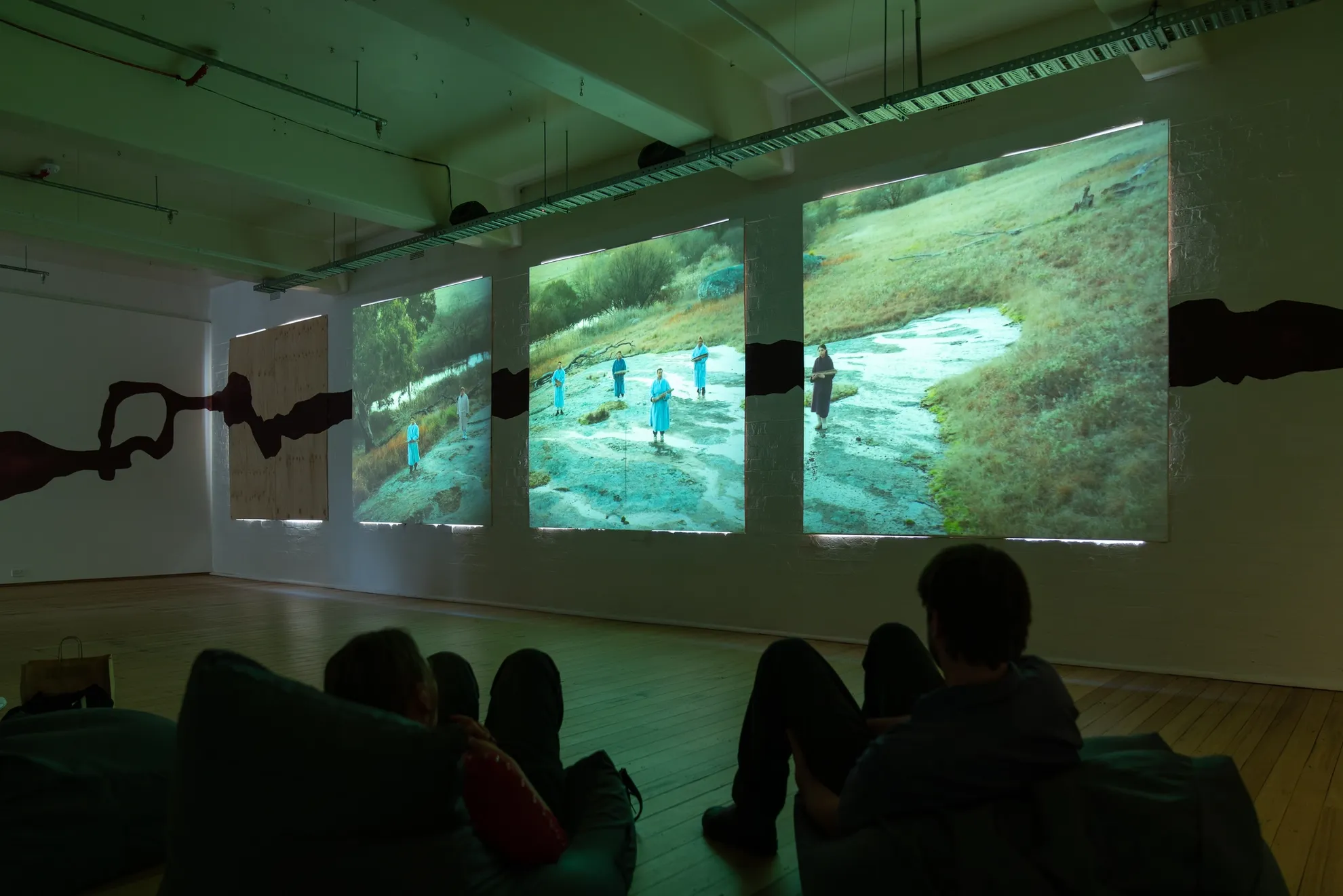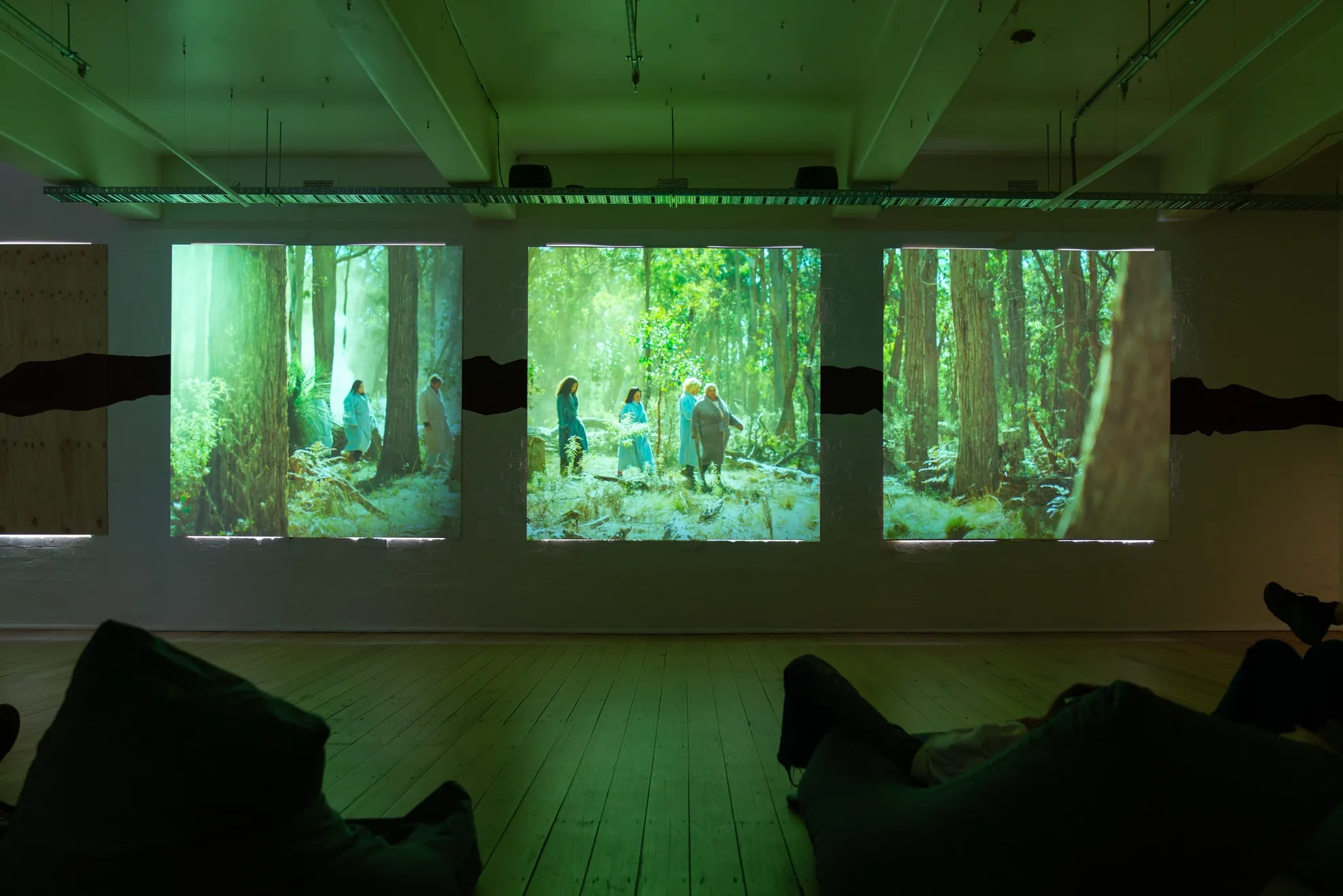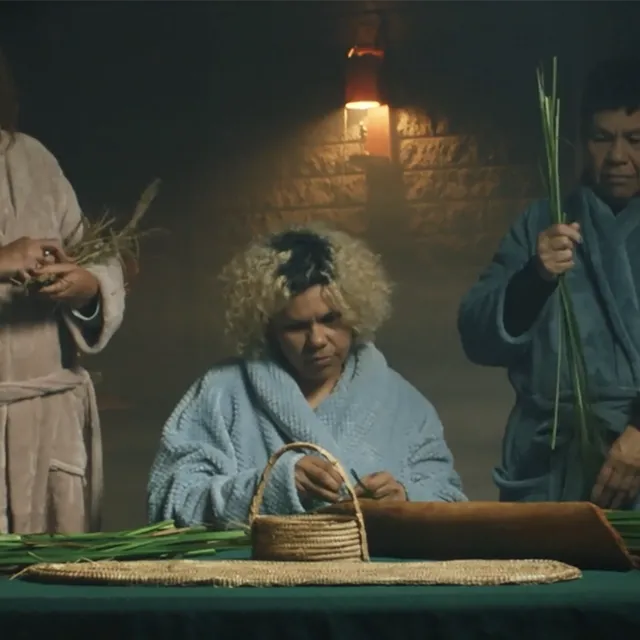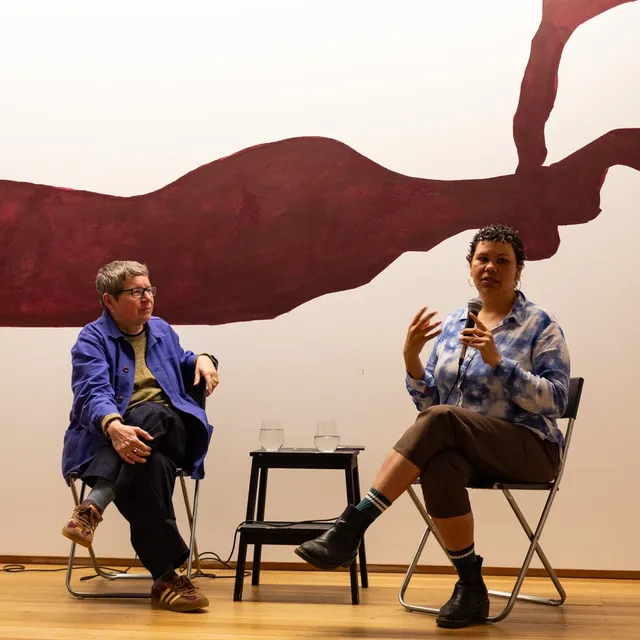Sebastian Henry-Jones
“On ARKAN & IRBELA”
A collection of people stand together on a large, flat landform, pocked with variations across its surface. Long, orange tipped grass slopes down towards the river, past shrubs, rocks, and the stubbed, curly branches of fallen trees.
Each member of the group wears a dressing gown, each is a different shade of blue or mauve, as though part of a pattern. They are spaced evenly across the enormous rock; so big that its sides must end somewhere outside the edge of the frame, covered by the orange tipped grass. I’m not sure whether to imagine it embedded deep within the countryside like a giant’s tooth, or as a part of the land itself. The people each hold a coolamon.

During the install of ARKAN & IRBELA, I watched Gabi Briggs use one as a surface to crush and hold fragments of earth – white ochre – that we then applied with water to the gallery window. It works to filter the light coming into the space in a way that renders the projected video work more legible to the eye. Since ARKAN & IRBELA opened, I’ve also noticed that the layer of ochre adds a feeling of privacy inside the gallery.
The group of people are members of Gabi’s extended family, and feature throughout what one West Space volunteer described quite aptly as Gabi’s ‘video poem’. Yes, moments throughout the video are punctuated by poetry and language, but there’s also an openness to the way that the work seems to elude any narrative form. A certain ambience that has the same soft effect on me that my favourite poems do.
West Space is located on the lands of Wurundjeri, while ARKAN & IRBELA depicts Anaiwan Country, Northern New South Wales. Of shooting the film on location, Gabi writes:
When looking for places to shoot on Country, I wanted to concentrate on locations that are accessible to the public and situated near Ingelba Aboriginal Reserve and Woolbrook, as well as the MacDonald River, given their significance to the project… We shot the film at publicly accessible spaces on this part of Anaiwan Country, as much of it is farmed land.
We filmed along Niangala Rd and Aberbaldie Nature Reserve. Aberbaldie Nature Reserve contains important habitats for an array of forest species in a relatively cleared landscape. Despite the incredible loss due to farming practices, we still have a strong cultural and spiritual connection to Place, fostered by memories passed down to us, connecting to those who have passed before us too.
Memories of places like Ingelba Aboriginal Reserve and the small town of Woolbrook feature in a book published by Gabi’s grandmother Patsy Cohen in 1990. Ingelba and the Five Black Matriarchs was a research project, tracing the history of her Community on Anaiwan Country after its fracturing due to colonisation. When the settlers arrived, they referred to the region as ‘New England’, the landscape – characterised by rolling hills and worn-down mountain peaks – reminding them of home. As such, the colonial process progressed very rapidly here: Gabi tells the story that within the first ten years of colonial occupation of the area, Anaiwan people were outnumbered by half a million cows, and that there were more people speaking English than the native language.

In 1893 an Aboriginal Reserve called ‘Ingelba’ was established by the NSW Aborigines Protection Board, lasting until the 1940s. Tracing her community’s history through the family trees of five matriarchs who lived at Ingelbah, Patsy Cohen was able to revive important cultural knowledge through her book. As a member of the stolen generation, she felt the need to bring Black Matriarchs together as an important entry in the archive for her Community. Gabi puts it as ‘returning knowledge back to Place and people.’
Gabi is a weaver. Not long before the opening of her West Space exhibition I saw a woven object of hers at Incinerator Gallery, in a powerful exhibition curated by Maya Hodge titled These Arms Hold. From what I know of artmaking, there is a high degree of knowledge, skill and understanding of material required to make the rifle that she produced for the exhibition. There is a scene in ARKAN & IRBELA in which Gabi and her family gather around a table, preparing lomandra for the weaving process. As a research project that looks to build on the knowledge produced by her grandmother, I can see the different ways that Gabi has masterfully woven elements from her nan’s book with those in the exhibition. The composition of many scenes in the film have been based on photographs from Patsy’s book, of family and Community Elders spending time together on Country.
Elsewhere, elements of the wall painting spanning the entirety of the gallery have also been lifted from Black Matriarchs; in particular, the long, amorphous form of the Macdonald river, which flows up and down Anaiwan Country. Gabi has painted it in such a way that it is visually ‘woven’ between the four boarded windows of the gallery, fusing them together. Rendered in a deep claret, it could also be thought of as blood, a life-force stretching across generations like a long strand of double-helix DNA.

By weaving disparate strands of material together they are made stronger as a unified and larger whole. Much of Patsy Cohen’s work was around Anaiwan kinship, which set the foundations for the revitalisation of the Anaiwan Skin System. This is described by Gabi as a network that:
assigns skin names that define our roles and relationships within the community and with Country. It governs social interactions, including marriage, through its structured skin groups and totems, ensuring cultural continuity and ethical conduct.
The dressing gowns worn by family members are colour coded according to the four distinct skins making up the Anaiwan skin network. If you were to draw straight lines between each figure standing on the rock according to their responsibilities to each other as necessitated by the skin network, I’m sure the lines would interlock as if woven. Though hundreds of years of colonisation have eroded Aboriginal Communities’ knowledge about their skin systems, Gabi describes her understanding of the lore as something instinctual, that underlies the ways she and her Community relate to each other, whether they know it or not.
This is particularly important in the context of a settler colony, in which the longform and less visible strategy of dispossession continues through the practice of assimilation. It’s much easier to assimilate an individual than a group of people who are connected to each other and the land you want to steal from them. The training of individualism in settler colonies is an important practice by which to maintain control. When Country is organised as private property for example, it inscribes the individual owner of it within the legal structures and social categories of the colonial authority.
On the other hand, Country that is collectively managed and cared for by its Rightful Custodians is inherently incompatible with regular institutions of Australian society. And so as a protocol that weaves Aboriginal communities together with Country, the skin system emerges as a way to understand this continuation of culture also as a vital form of collective Resistance.

Within ARKAN & IRBELA, weaving could be considered as the gesture of ‘re-tracing.’ Gabi has carefully considered what the right translation of her grandmother’s work might be in the context of an art exhibition. The material aspects of exhibition-making become a means by which the artist can re-trace her nan’s hand and eye, and therefore her research. It�’s in the hand-painted river, in the re-composition of photographs in the film, the boarded up windows; reminiscent of DIY dwellings erected on Ingelbah Aboriginal reserve or Armidale Aboriginal Reserve (aka Silver City) by Anaiwan people.
Projected onto these boards, the three channel film has a kind of choreography that renders the content displayed on each as woven. ARKAN & IRBELA demonstrates that the simple act of re-tracing, re-presenting, re-articulating, and of returning to the source, is akin to creating something new. This thinking is also clear in the formation of the English word ‘research’. That is, knowledge is not created in a vacuum.
ARKAN & IRBELA calls us to consider what generations upon generations of ongoing connection to a particular place means, and what kinds of knowledge might be generated from a longstanding connection to place.
If generations of your ancestors are buried in the location that you live, their matter absorbed into the soil that sustains the plants and animals around you, how are you to understand the concept of family? Would it resemble something like a skin network? For non-Indigenous people in Australia whose ancestors are buried overseas, or those moving from city to city for work and opportunity, we might never know.

Sebastian Henry-Jones is the Curator at West Space. His curatorial approach is led by an interest in DIY thinking, and situated in the context provided by the gentrification of Sydney and Melbourne’s cultural landscapes.



